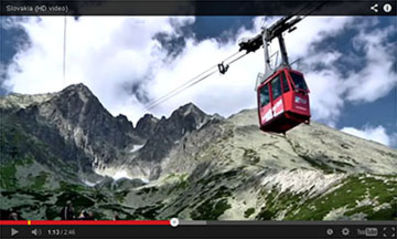TRENČÍN, centre of region Považie, stretches below the famous Castle of Trenčín. It is the town with rich history and interesting present characterized by close bonds with the neighbouring Moravia and Czechia.
HISTORY
A unique authentic proof of the presence of Roman legions in the territory of Trenčín exists. The inscription on the steep face of the castle rock was carved in the memory of the victory over the Quads in 179 AD.
The first written mention of the settlement situated below the bulky castle next to the old trade route is from 1111. The settlement fully developed again by the end of the 13th century when the Castle of Trenčín was acquired by the magnate Matúš Čák, who became practically the sovereign ruler of the whole territory of what is today Slovakia. He owned about 30 Slovak castles. Trenčín obtained various privileges and rights in the Middle Ages. King Sigismund promoted it to free royal borough in 1412 with similar rights as those, for instance, of Buda.
In the second half of the 19th century Trenčín became an important commercial and industrial centre of the Central Považie when railway connection with Žilina was finished. In the second half of the 20th century the textile, food processing and machinery developed above all. Activitie associated with exhibitions later prevailed in Trenčín. The historical core of the town revived again after 1989 and the prevailing part of historical monuments has been reconstructed.
MONUMENTS
The buildings in the historic centre are parts of the Town Monument Reserve.
The Roman military settlement then called Laugaricio (today Trenčín) was the northernmost point of the Roman legions of Emperor Marcus Aurelius in the area of central Europe. The inscription on the steep face of the castle rock is observable from the window of the view terrace of the restaurant in the local Tatra Hotel.
The Castle of Trenčín built on top of a steep rock is undoubtedly the dominant of the town and the region. Varied exhibitions, medieval games and attractive night sightseeing are organised at the castle throughout the year. The Castle became popular above all due to its most powerful owner the magnate Matúš Čák Trenčiansky, also referred to as the “Master of the Váh and the Tatras”. Perhaps every child in Slovakia knows the 80-m deep castle well.
The fortified area called Mariánsky hrad or Mariánska hora spreads between the castle and town centre. It consists of the Roman Catholic parish church of Nativity of the Virgin Mary. It is accessible from the parish church by sheltered staircase built in 1568.
The originally Jesuit, later Piarist monastery and church of St. František Xaverský were built in the Neo Baroque style in the 17th century. The monastery is the venue of classical music concerts in summer.
The Town Tower offers a nice view of all dominants in the town including the popular fountain with the statue of goblin on the square Štúrovo námestie and the Synagogue built in the oriental style.
RECOMMENDED TRIP
The instructive path running through the landscape park of Breziny may be also a refreshing part of the trip to Trenčín. The popular destination is the pilgrim place Skalka with a church and ruins of an old monastery, the spa Trenčianske Teplice and the mountain Inovec.
Source: Vydavateľstvo Dajama











